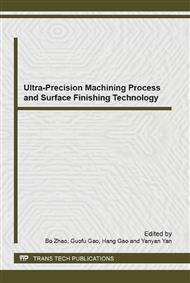p.36
p.40
p.44
p.48
p.52
p.58
p.63
p.68
p.72
Study on Polishing Technology for Hard-Brittle Materials by a Micro Abrasive Water Jet
Abstract:
s: Abrasive jet micromachining is considered as a promising precision processing technology for brittle materials such as silicate glass and silicon nitride that are increasingly used in various applications. In this study, some polishing experiments are conducted for hard-brittle materials by a micro slurry jet. The results show that the morphology and the integrity of the material surface are improved greatly after polishing. The average roughness (Ra) value of the silicate glass decrease from 2.32μm to 0.35μm and the average roughness (Ra) value of the Si3N4 decrease from 2.63μm to 0.34μm. The material removal mechanism and the surface formation mechanism are studied. The factors to influence the surface morphology, the surface quality and the surface roughness are analyzed in order to take measures to improve the surface quality and reduce the surface roughness value.
Info:
Periodical:
Pages:
52-57
Citation:
Online since:
October 2014
Authors:
Keywords:
Price:
Сopyright:
© 2014 Trans Tech Publications Ltd. All Rights Reserved
Share:
Citation:


